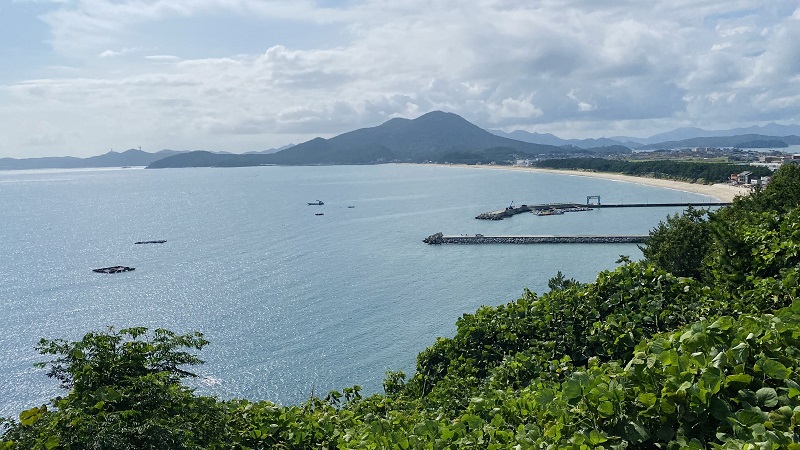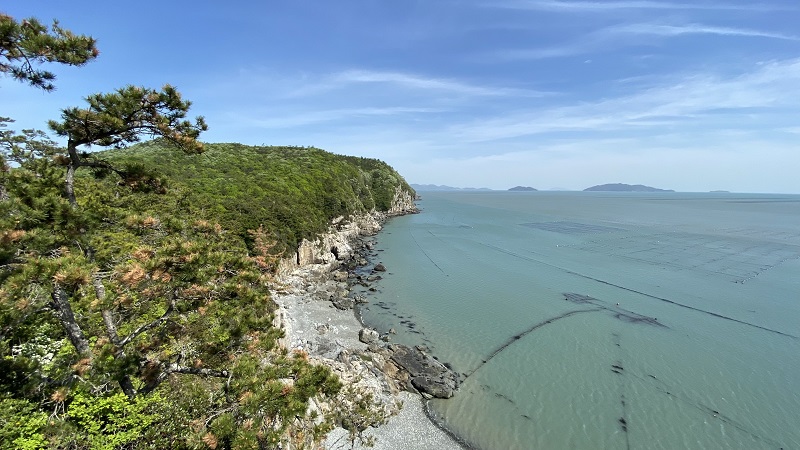More Than Just a Beach: Spending a Week in Wando County
By Isaiah Winters
Before the last of this year’s summer weather left us, I spent a week in Wando County poking around in search of sites other than the well-known Myeongsasimni Beach. In this month’s iteration of “Lost,” we’ll scale the county’s highest mountain peak, hike down to one of its deserted pebble beaches, and explore its stunning portion of a non-contiguous national park where I ran into Korean soldiers and got kicked out. So, without further ado, lace up your sturdiest footwear and follow me.
Sangwang-bong – Peak Wando
Not many visitors bother to go hiking while in Wando County, especially when the beach beckons in warmer months, but there are some impressive trails and peaks worth visiting if you have the time. For example, the big island of Wando maxes out at the 644-meter Sangwang-bong (상왕봉), a lush mountain vantage encompassed by sea-spangled views. The peak has an impressive wooden deck that terminates at a pair of glass-floored cantilevers you can walk out onto for an added thrill. If you summit Sangwang-bong on a clear day, gazing at the island-studded seascape will make returning home to your concrete metropolis seem utterly depressing, which it is.

There are many trails up to Sangwang-bong, so you can pick your starting point according to your hiking prowess and desired experience. I’m a novelty hound but also incurably lazy, so I drove most of the way up and parked at the Wando Nature Forest Lodge (완도자연휴양림), my justification being that the forest trail that begins from there is epic and otherworldly – and I’m not wrong. Like something out of Korean Dr. Seuss, there are unique plants that only thrive in the thin subtropical sliver along Korea’s south coast. If you traverse this forest area when the mountain is veiled in mist, the eeriness will crank up to eleven and afford you some unforgettable photo opportunities. Rain or shine, taking the shortcut through this forest never disappoints.
Lesson learned: There is beauty in being lazy.
Sinji-do’s Deserted Beach
Myeongsasimni Beach tends to hog all of Wando County’s glory, so few visitors ever realize it’s flanked by excellent coastal trails that don’t get nearly as much love as they should. The coastal trail to the east of the beach leads down to the southernmost point of Sinji-do where, after nerding out on KakaoMap for far too long, I noticed a deserted pebble beach nestled within a rocky cove. I could just barely make out a faint trail that went all the way there, so I decided to spend a day hiking down to the end to see if this wild beach was any good. Long story short, the “Forest Therapy Trail” (숲 치유 길) is awesome, but the deserted beach is garbage – quite literally.
Despite facing down an onslaught of mosquitoes, ticks, spiders, and snakes, the death march to garbage beach was ironically rewarding for everything but the beach itself. To clear the forest line and actually step foot on the beach, I had to lurch through a heap of fishing-related garbage lining the shore, only to be greeted by the stench of stagnant tidepools and hordes of disgusting sea slaters (갯강구) scurrying in every direction. Resembling cockroaches, these creatures are often found along rocky coastlines that smell terrible, so I consider them a bad omen. Though exhausted, sweat-soaked, and wanting nothing more than to take a victory dip, I lost the urge and made the arduous march back to the soft, sandy embrace of Myeongsasimni Beach, where I arrived just in time to swim as the sun set.
Lesson learned: If nobody goes, there’s a reason why.
Wando’s Non-Contiguous National Park
South Jeolla Province has a unique, non-contiguous national park stretching from the Yeosu Peninsula in the southeast all the way to the westernmost islands of Sinan County, and roughly in the center of that scattered park is Wando. The unwieldily named Dadohaehaesang National Park (다도해해상국립공원) has an incredibly beautiful stretch along Wando’s south coast with one of the widest pebble beaches in the country, not to mention a coastal hiking trail containing kilometers of breathtaking views culminating at the edge of a peninsula, beyond which is a military checkpoint. I stumbled upon a few soldiers there while filming the nearby trenches, and they politely asked me to delete my footage of that area. I obliged, and they were surprisingly cool about the whole encounter. Things could have gone way worse, so I count myself lucky.

On my first visit to the park back in 2021, I looked all around but found no signs prohibiting swimming, so I swam for half an hour at the pebble beach and, just as I was drying off to put my shirt back on, a park ranger spotted me and started shouting that swimming wasn’t allowed. I told her I hadn’t seen any “No Swimming” signs, and she didn’t say I was wrong. (There were tons of signs prohibiting all sorts of things there, but none mentioned swimming.) Anyway, while she was kicking me out, she couldn’t help but share her love of the park with me, so she took me on a little tour. In a forest alcove, she picked up some dry leaves, crushed them, and cupped them under my nose to enjoy the fragrance. I wish I could remember the name of those leaves. Next, she invited me to see the aquarium, where I gawked at its many seahorses and their peculiar prehensile tails. Then she took me to the head office, where she saw to it that I left with a park brochure. She’s an absolute sweetheart who runs a minbak in Haenam County on the side. Today we follow each other on Instagram.
Lesson learned: Swimming’s only prohibited if you get caught.

Honorable Mention – Myeongsasimni’s Main Parking Lot Restroom
One morning during my week-long stay in Wando, I was making my way to the coastal trail west of Wando’s famed beach when a sudden downpour left me scrambling for a dry place to wait out the storm. Luckily, the main restroom at the beach parking lot had a large overhang and a single plastic chair, where I sat in front of a colorful tiled mural and listened to the rain. Although the downpour didn’t let up for about two hours, I found the experience oddly relaxing – that is, until my stomach began churning, and I had to “lose some weight” in the adjacent men’s room. To my utter delight, I discovered that my stall had a functioning bidet. Returning to my plastic chair lighter and refreshed, I thought about what might have happened had I gotten the bubble guts midway through the day’s aborted hike. With that thought, I smiled.
Lesson learned: If you’ve gotta go, go with a smile.


The Author
Hailing from Chino, California, Isaiah Winters is a pixel-stained wretch who loves writing about Gwangju and Honam, warts and all. He’s grateful to have written for the Gwangju News for over five years. More of his unique finds can be seen on Instagram @d.p.r.kwangju and YouTube at Lost in Honam.




